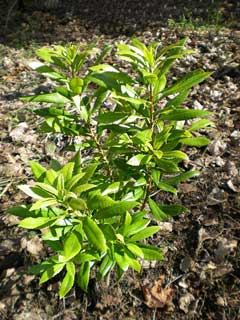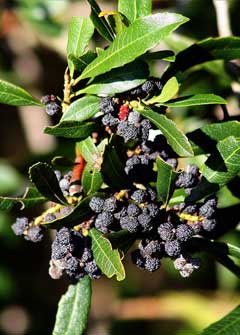 |
|
http://commons.wikimedia.org/wiki/User:Murderbike |
 |
| www.flickr.com/photos/23326361@N04 |
Translate this page:
Summary
Myrica species,
Myrica is a genus of small trees and shrubs widely distributed in Africa, Asia, Europe, North America and South America, with most species being evergreen and nitrogen-fixing. There are better-tasting berries, but bayberry’s other qualities make it worth considering. California Bayberry (M. californica) is a shrub growing to 4m (13ft) native to the Pacific Ocean coast of North America. It grows well on cool, moist coastlines, making it a good seaside windbreak. The fruit is edible, raw or cooked and has a large seed with little edible flesh. Wax Myrtle (M. cerifera) has smaller fruit and edible leaves for food flavouring. The leaves are aromatic, attractive, and a suitable substitute for bay leaves, which are used in flavouring soups and stews or as a robust tea. Faya Bayberry (M. faya), native to Native to Azores, Canary Is., Madeira and Portugal, is commonly used in reforestation and erosion control in arid environments, particularly volcanic soils. The small, dark red to purple berries of M. faya are technically edible, though not commonly consumed due to their astringent taste. They can be used to make jams or jellies when sweetened. Its medicinal properties, particularly its astringent and anti-inflammatory uses, have been traditionally recognized, especially in treating digestive issues, wounds, and infections. However, its use today is more limited compared to other species.
There are various ways to preserve fruits, such as drying, canning, or soaking them in liquor. Fruits can generally be categorized into two main types: sour fruits, commonly used for making dried fruits, and sweet fruits, typically consumed fresh or used for making juice. Bayberry fruit after five years.
Harvesting: Late summer to early autumn.
Bloom Color: Green. Main Bloom Time: Early spring, Late spring, Mid spring. Form: Rounded, Vase.
Physical Characteristics

 Myrica californica is an evergreen Shrub growing to 4 m (13ft 1in) at a medium rate.
Myrica californica is an evergreen Shrub growing to 4 m (13ft 1in) at a medium rate.
See above for USDA hardiness. It is hardy to UK zone 7. It is in leaf all year, in flower in May, and the seeds ripen from September to October. The species is monoecious (individual flowers are either male or female, but both sexes can be found on the same plant) and is pollinated by Wind. The plant is not self-fertile.
It can fix Nitrogen.
It is noted for attracting wildlife.
Suitable for: light (sandy), medium (loamy) and heavy (clay) soils and prefers well-drained soil. Suitable pH: mildly acid and neutral soils and can grow in very acid soils.
It can grow in semi-shade (light woodland) or no shade. It prefers moist soil. The plant can tolerates strong winds but not maritime exposure.
UK Hardiness Map
US Hardiness Map
Synonyms
Plant Habitats
Woodland Garden Sunny Edge; Dappled Shade;
Edible Uses
Edible Parts: Fruit
Edible Uses:
Fruit - raw or cooked[105, 177]. The fruit is about 6mm in diameter with a large seed[200]. There is very little edible flesh and the flavour of this is poor[200, K].
References More on Edible Uses
Medicinal Uses
Plants For A Future can not take any responsibility for any adverse effects from the use of plants. Always seek advice from a professional before using a plant medicinally.
Stomachic
The bark and root bark is used in the treatment of gastrointestinal disorders and infections[238].
References More on Medicinal Uses
The Bookshop: Edible Plant Books
Our Latest books on Perennial Plants For Food Forests and Permaculture Gardens in paperback or digital formats.

Edible Tropical Plants
Food Forest Plants for Hotter Conditions: 250+ Plants For Tropical Food Forests & Permaculture Gardens.
More

Edible Temperate Plants
Plants for Your Food Forest: 500 Plants for Temperate Food Forests & Permaculture Gardens.
More

More Books
PFAF have eight books available in paperback and digital formats. Browse the shop for more information.
Shop Now
Other Uses
Dye Wax Wood
Agroforestry uses: Bayberry is useful as a windbreak or hedge. Its dense foliage provides shelter for wildlife, and it can also help with soil stabilization due to its extensive root system. A wax covering on the fruit is extracted by scalding the fruit with boiling water and immersing them for a few minutes, the wax floats to the surface and is then skimmed off. The fruit is then boiled in water to extract the wax from the pulp and once more the wax is skimmed off. It is then strained through a muslin cloth and can be used to make aromatic candles[106, 245]. Candles made from this wax are quite brittle but are less greasy in warm weather[213]. They are slightly aromatic and do not smoke when put out, making them much more pleasant to use that wax or tallow candles[213]. The wax is also used in making soaps[213]. To date (07/12/95) plants growing on our Cornish trial grounds have fruited freely but have not produced much wax. They produced somewhat more after the hot summer of 1995, but there was still not enough to make extraction worthwhile[K]. A grey-brown and a maroon-purple dye are obtained from the fresh or dried berries[168]. Wood - heavy, very hard, strong, brittle, close grained[82]. 1. Nectary - Flowers rich in nectar and pollen:
Yes – Bayberry species produce small flowers that attract pollinators such as bees, although they are not highly showy or fragrant.
2. Wildlife - Food (Fruit, Seeds, Leaf litter, Shelter, Nesting, Roosting):
Yes – Bayberry produces waxy berries that are an important food source for birds, especially in winter. The dense shrubs provide shelter and cover for birds and other wildlife.
3. Invertebrate Shelter (Overwintering sites, Leaf litter, Groundcover):
Yes – The dense growth of Bayberry shrubs can provide good overwintering sites for invertebrates, and their leaf litter can create habitats for ground-dwelling beneficial organisms.
4. Pest Confuser (Smell):
No – Bayberry is not typically known for producing scents that confuse pests, though its aromatic leaves may have mild repellent properties.
Special Uses
Food Forest Nitrogen Fixer Scented Plants
References More on Other Uses
Cultivation details
Landscape Uses:Border, Hedge, Screen, Seashore, Specimen. Prefers a moist soil[200]. Grows well in an open position in a well-drained soil in sun or light shade[200]. Thrives in any ordinary garden soil according to one report[11] whilst another says that it thrives in an acid soil[182]. Prefers a lime-free loamy or peaty soil[1]. Plants can be cut back to the ground in severe winters in many parts of Britain[1, 11], but they are well suited to the milder parts of the country[11, 59] where they are fast-growing and produce fruit within 5 years from seed[K]. They succeed and fruit well on a south facing wall at Kew[K]. Plants in this genus are notably resistant to honey fungus[200]. The fruit is covered with a deposit of wax that has a balsamic odour[245]. Many species in this genus have a symbiotic relationship with certain soil micro-organisms, these form nodules on the roots of the plants and fix atmospheric nitrogen. Some of this nitrogen is utilized by the growing plant but some can also be used by other plants growing nearby[200]. Special Features:Attracts birds, North American native, Fragrant foliage, Attracts butterflies, Inconspicuous flowers or blooms. Bayberry plants are typically dioecious, meaning that they have separate male and female plants. Therefore, they are not self-fertile and require both male and female plants for fruit production. The fruit is usually harvested in late summer to early autumn, depending on the species and local climate.
Bayberry typically flowers in spring with the timing varying slightly by species and climate. Bayberry is a moderately fast-growing plant, often establishing itself quickly and reaching maturity within 3 to 5 years.
References Carbon Farming Information and Carbon Sequestration Information
Temperature Converter
Type a value in the Celsius field to convert the value to Fahrenheit:
Fahrenheit:
The PFAF Bookshop
Plants For A Future have a number of books available in paperback and digital form. Book titles include Edible Plants, Edible Perennials, Edible Trees,Edible Shrubs, Woodland Gardening, and Temperate Food Forest Plants. Our new book is Food Forest Plants For Hotter Conditions (Tropical and Sub-Tropical).
Shop Now
Plant Propagation
Seed - best sown as soon as it is ripe in the autumn in a cold frame[78]. Stored seed germinates more freely if given a 3 month cold stratification and then sown in a cold frame[78]. Germination is usually good[78]. Prick out the seedlings into individual pots when they are large enough to handle and grow them on in the cold frame for the first winter. Plant out in late spring or early summer[K]. Cuttings of half-ripe wood, 5 - 8cm with a heel, July/August in a frame. Pot up and overwinter in a cold frame then plant out in late spring or early summer. Fair to good percentage[78]. Layering in spring[200].
Other Names
If available other names are mentioned here
Native Range
NORTHERN AMERICA: United States, Oregon (west), Washington (west), California (west),
Weed Potential
Right plant wrong place. We are currently updating this section.
Please note that a plant may be invasive in one area but may not in your area so it's worth checking.
Conservation Status
IUCN Red List of Threatened Plants Status :

Growth: S = slow M = medium F = fast. Soil: L = light (sandy) M = medium H = heavy (clay). pH: A = acid N = neutral B = basic (alkaline). Shade: F = full shade S = semi-shade N = no shade. Moisture: D = dry M = Moist We = wet Wa = water.
Now available:
Food Forest Plants for Mediterranean Conditions
350+ Perennial Plants For Mediterranean and Drier Food Forests and Permaculture Gardens.
[Paperback and eBook]
This is the third in Plants For A Future's series of plant guides for food forests tailored to
specific climate zones. Following volumes on temperate and tropical ecosystems, this book focuses
on species suited to Mediterranean conditions—regions with hot, dry summers and cool, wet winters,
often facing the added challenge of climate change.
Read More
Expert comment
Author
Cham.
Botanical References
1160200
Links / References
For a list of references used on this page please go here
Readers comment